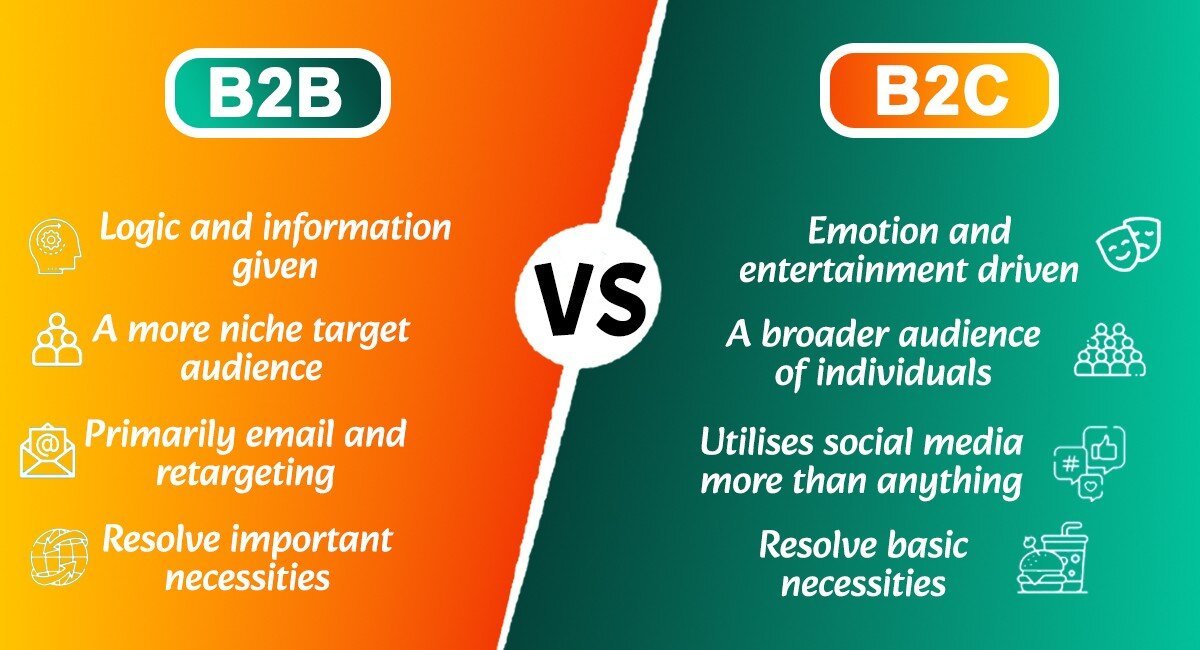
From B2B to B2C: How to Tailor Marketing Strategies Across Audiences
Posted on October 4, 2023
In the dynamic world of marketing, understanding the nuances between B2B (Business to Business) and B2C (Business to Consumer) is crucial for success. While both segments aim to drive sales and build brand loyalty, their audiences, purchasing processes, and marketing strategies can differ significantly. This blog explores how businesses can effectively tailor their marketing strategies when transitioning from B2B to B2C.
Understanding the Differences: B2B vs. B2C
Before diving into strategies, it’s essential to grasp the fundamental differences between B2B and B2C:
- Target Audience:
- B2B: Focuses on businesses and organizations. The target audience consists of decision-makers like managers, executives, and procurement officers.
- B2C: Targets individual consumers. The audience is broader and includes various demographics based on interests, age, and spending habits.
- Decision-Making Process:
- B2B: The buying process is often lengthy and involves multiple stakeholders. Decisions are made based on logic, ROI, and long-term relationships.
- B2C: Consumers typically make quicker purchasing decisions based on emotions, brand perception, and immediate needs.
- Sales Cycle:
- B2B: Generally longer and more complex, often requiring negotiations and tailored solutions.
- B2C: Shorter and more transactional, with a focus on impulse buying and convenience.
- Content Focus:
- B2B: Emphasizes educational content, case studies, whitepapers, and in-depth product information.
- B2C: Relies on engaging content, such as videos, social media posts, and promotional campaigns that resonate with consumers’ lifestyles.
Tailoring Marketing Strategies for B2C
When transitioning from B2B to B2C, businesses must adjust their marketing strategies to effectively reach and engage consumers. Here are several key strategies to consider:
- Define Your B2C Target Market:
- Conduct thorough market research to identify your target audience’s demographics, preferences, and behaviors. Create buyer personas that reflect the characteristics of your ideal customers.
- Use tools like surveys, focus groups, and social media insights to gather valuable data.
- Focus on Emotional Engagement:
- B2C marketing often hinges on emotional connections. Craft marketing messages that resonate with your audience’s feelings and values.
- Use storytelling techniques to showcase how your products or services can enhance consumers’ lives, solve their problems, or fulfill their desires.
- Utilize Multi-Channel Marketing:
- Leverage a mix of marketing channels to reach consumers where they are. This includes social media, email marketing, SEO, content marketing, and paid advertising.
- Tailor your messaging for each platform. For instance, Instagram might focus on visually appealing content, while email can provide more detailed information.
- Invest in Branding:
- Develop a strong, recognizable brand identity that differentiates you from competitors. Consistent branding across all touchpoints helps build trust and loyalty among consumers.
- Ensure your brand voice, colors, and messaging align with your target audience’s preferences.
- Create Engaging Content:
- Shift from purely informative content to more engaging formats. Use videos, infographics, and interactive content to capture attention.
- Consider user-generated content and influencer partnerships to enhance authenticity and reach.
- Leverage Social Proof:
- Showcase testimonials, reviews, and case studies to build credibility. Consumers often rely on the experiences of others before making purchasing decisions.
- Use social media to highlight customer success stories and encourage happy customers to share their experiences.
- Optimize the Customer Journey:
- Map out the customer journey from awareness to purchase, ensuring a seamless experience. Make it easy for consumers to find, explore, and purchase your products.
- Implement features like easy navigation, mobile optimization, and secure payment options to enhance the online shopping experience.
- Personalize Marketing Efforts:
- Utilize data and analytics to personalize marketing messages. Target consumers with tailored offers and recommendations based on their behavior and preferences.
- Email marketing can be particularly effective for personalization, allowing you to send relevant content and promotions to specific segments.
- Monitor and Adapt:
- Continuously track the performance of your marketing strategies. Use analytics tools to measure engagement, conversion rates, and customer feedback.
- Be prepared to adapt your approach based on insights and trends. The B2C landscape is ever-changing, and flexibility is key to staying relevant.
Conclusion
Transitioning from B2B to B2C marketing requires a thoughtful approach to understanding the distinct needs and behaviors of individual consumers. By tailoring marketing strategies to engage emotionally, leverage multi-channel outreach, and prioritize personalization, businesses can effectively reach and resonate with their new audience. The shift may be challenging, but with the right strategies in place, companies can thrive in the vibrant world of B2C marketing.
Categories: Sales & Marketing
